Photos from the field: capturing the grandeur and heartbreak of Tasmania's giant trees
- Written by Jennifer Sanger, Research Associate, University of Tasmania
Environmental scientists see flora, fauna and phenomena the rest of us rarely do. In this new series, we’ve invited them to share their unique photos from the field.
Tasmania’s native forests are home to some of the tallest, most beautiful trees in the world. They provide a habitat for many species, from black cockatoos and masked owls to the critically endangered swift parrot.
But these old, giant trees are being logged at alarming rates, despite their enormous ecological and heritage value (and untapped tourism potential). Many were also destroyed in Tasmania’s early 2019 fires.
Read more: Comic explainer: forest giants house thousands of animals (so why do we keep cutting them down?)
Former Greens leader Bob Brown recently launched a legal challenge to Tasmania’s native forest logging. And this year, Forestry Watch, a small group of citizen scientists, found five giant trees measuring more than five metres in diameter inside logging coupes. “Coupes” are areas of forest chopped down in one logging operation.
These trees are too important to be destroyed in the name of the forestry industry. This is why my husband Steve Pearce and I climb, explore and photograph these trees: to raise awareness and foster appreciation for the forests and their magnificent giants.
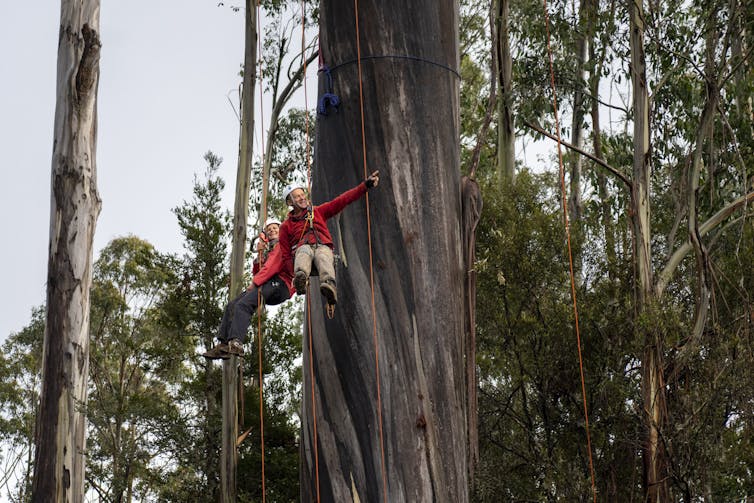 Climbing trees is not just for the young, but for the young at heart. Kevin is in his early 70’s and helps us with measuring giant trees.
Steve Pearce/The Tree Projects, Author provided
Climbing trees is not just for the young, but for the young at heart. Kevin is in his early 70’s and helps us with measuring giant trees.
Steve Pearce/The Tree Projects, Author provided
What makes these trees so special?
Eualypytus regnans, known more commonly as Mountain Ash or Swamp Gum, can grow to 100 metres tall and live for more than 500 years. For a long time this species held the record as the tallest flowering tree. But last year, a 100.8 m tall Yellow Meranti (Shorea faguetiana) in Borneo, claimed the title — surpassing our tallest Eucalypt, named Centrioun, by a mere 30 centimetres.
Centrioun still holds the record as the tallest tree in the southern hemisphere. But five species of Eucalypt also grow above 85 m tall, with many ranking among some of the tallest trees in the world.
It’s not only their height that make these trees special, they’re also the most carbon dense forests in the world, with a single hectare storing more than 1,867 tonnes of carbon.
Read more: Money can't buy me love, but you can put a price on a tree
Our giant trees and old growth forests provide a myriad of ecological services such as water supply, climate abatement and habitat for threatened species. A 2017 study from the Central Highlands forests in Victoria has shown they’re worth A$310 million for water supply, A$260 million for tourism and A$49 million for carbon storage.
This significantly dwarfs the A$12 million comparison for native forest timber production in the region.
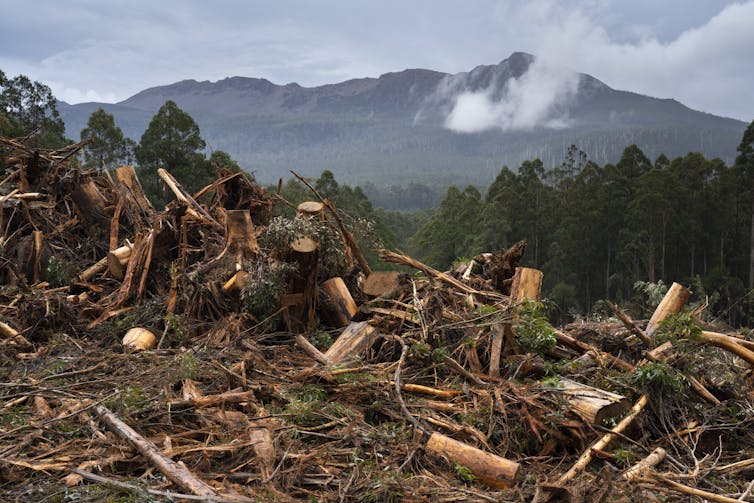 Chopping down old growth trees doesn’t make economic sense.
Steve Pearce/The Tree Projects, Author provided
Chopping down old growth trees doesn’t make economic sense.
Steve Pearce/The Tree Projects, Author provided
Tasmania’s Big Tree Register
Logging organisation Sustainable Timber Tasmania’s giant tree policy recognises the national and international significance of giant trees. To qualify for protection, trees must be at least 85 m tall or at least an estimated 280 cubic metres in stem volume.
While it’s a good place to start, this policy fails to consider the next generation of big, or truly exceptional trees that don’t quite reach these lofty heights.
That’s why we’ve created Tasmania’s Big Tree Register, an open-source public record of the location and measurements of more than 200 trees to help adventurers and tree-admirers locate and experience these giants for themselves. And, we hope, to protect them.
Last month, three giant trees measuring more than 5 m in diameter were added to the register. But these newly discovered trees are located in coupe TN034G, which is scheduled to be logged this year.
Logging is a very poor economic use for our forests. Native forest logging in Tasmania has struggled to make a profit due to declining demand for non-Forest Stewardship Council certified timber, which Sustainable Timber Tasmania recently failed. In fact, Sustainable Timber Tasmania sustained an eye watering cash loss of A$454 million over 20 years from 1997 to 2017.
Read more: Summer bushfires: how are the plant and animal survivors 6 months on? We mapped their recovery
The following photos can help show why these trees, as one of the great wonders of the world, should be embraced as an important part of our environmental heritage, not turned to wood chips.
 Steve Pearce/The Tree Projects, Author provided
It’s not often you get to see the entirety of a tree in a single photo. This tree above is named Gandalf’s Staff and is a Eucalyptus regnans, measuring 84 m tall.
While Mountain Ash is the tallest species, others in Tasmania’s forests are also breathtakingly huge, such as the Tasmanian blue gum (Eucalyptus globulus) at 92 m, Manna gum (Eucalyptus viminalis) at 91 m, Alpine ash (Eucalyptus delegatensis) at 88 m and the Messmate Stringybark (Eucalyptus obliqua) at 86 m.
Steve Pearce/The Tree Projects, Author provided
It’s not often you get to see the entirety of a tree in a single photo. This tree above is named Gandalf’s Staff and is a Eucalyptus regnans, measuring 84 m tall.
While Mountain Ash is the tallest species, others in Tasmania’s forests are also breathtakingly huge, such as the Tasmanian blue gum (Eucalyptus globulus) at 92 m, Manna gum (Eucalyptus viminalis) at 91 m, Alpine ash (Eucalyptus delegatensis) at 88 m and the Messmate Stringybark (Eucalyptus obliqua) at 86 m.
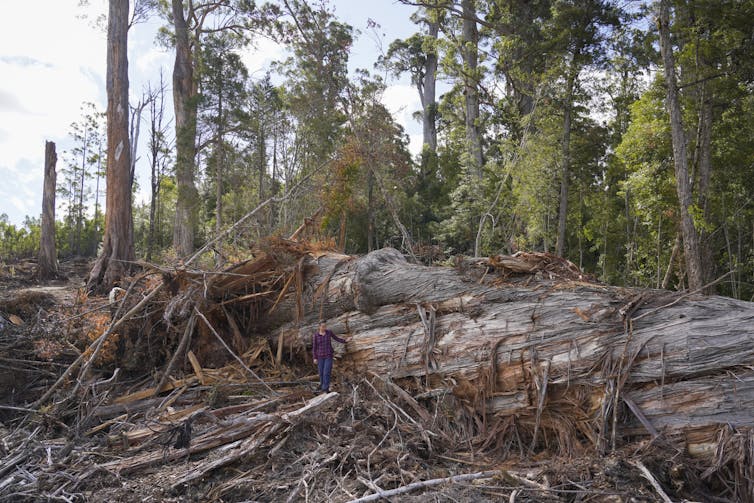 Steve Pearce/The Tree Projects, Author provided
This giant tree, pictured above, was a Messmate Stringybark that was felled in coupe, but was left behind for unknown reasons. Its diameter is 4.4 metres. Other giant trees like this were cut down in this coupe, many of which provided excellent nesting habitat for the critically endangered swift parrot.
Steve Pearce/The Tree Projects, Author provided
This giant tree, pictured above, was a Messmate Stringybark that was felled in coupe, but was left behind for unknown reasons. Its diameter is 4.4 metres. Other giant trees like this were cut down in this coupe, many of which provided excellent nesting habitat for the critically endangered swift parrot.
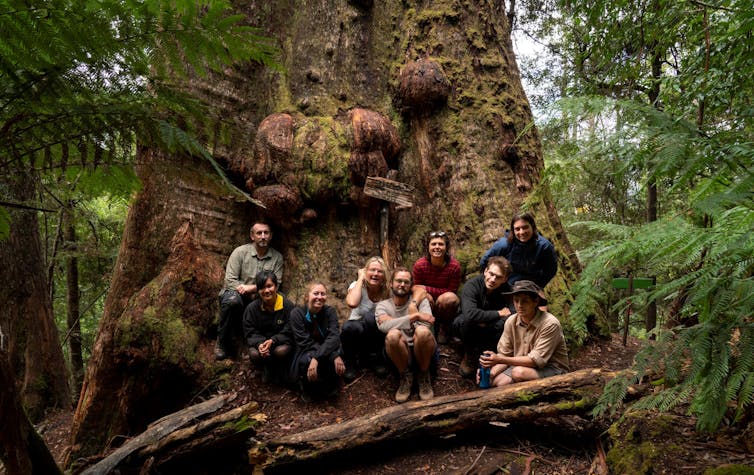 The citizen science group Forestry Watch helps search for and measure giant trees in Tasmania.
Steve Pearce/The Tree Projects, Author provided
Old-growth forests dominated by giant trees are excellent at storing large amounts of carbon. Large trees continue to grow over their lifetime and absorb more carbon than younger trees.
The citizen science group Forestry Watch helps search for and measure giant trees in Tasmania.
Steve Pearce/The Tree Projects, Author provided
Old-growth forests dominated by giant trees are excellent at storing large amounts of carbon. Large trees continue to grow over their lifetime and absorb more carbon than younger trees.
 Steve Pearce/The Tree Projects, Author provided
The tree in the photo above is called Obolus, from Greek mythology, with a diameter of 5.1 m. Names are generally given to trees by the person who first records them, and usually reflect the characteristics of the tree or tie in with certain themes.
For example, several trees in a valley are all named after Lord of the Rings characters, such as Gandalf’s Staff (pictured above), Fangorn and Morannon.
Steve Pearce/The Tree Projects, Author provided
The tree in the photo above is called Obolus, from Greek mythology, with a diameter of 5.1 m. Names are generally given to trees by the person who first records them, and usually reflect the characteristics of the tree or tie in with certain themes.
For example, several trees in a valley are all named after Lord of the Rings characters, such as Gandalf’s Staff (pictured above), Fangorn and Morannon.
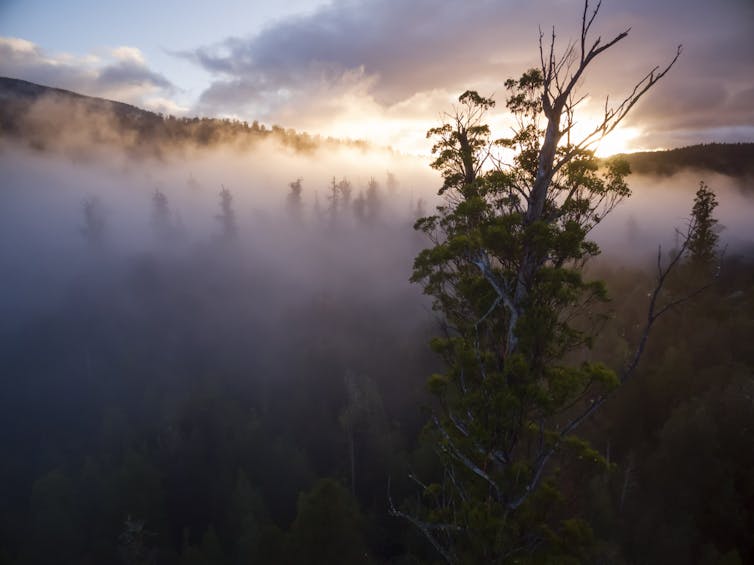 Steve Pearce/The Tree Projects, Author provided
Giant trees are typically associated with Californian Redwoods or the Giant Sequoias in the US, where tall tree tourism is huge industry. The estimated revenue in 2012 from just four Coastal Redwood reserves is A$58 million dollars per year, providing more than 500 jobs to the local communities.
Few Australians are aware of our own impressive trees. We could easily boost tourism to regional communities in Tasmania if the money was invested into tall tree infrastructure.
Steve Pearce/The Tree Projects, Author provided
Giant trees are typically associated with Californian Redwoods or the Giant Sequoias in the US, where tall tree tourism is huge industry. The estimated revenue in 2012 from just four Coastal Redwood reserves is A$58 million dollars per year, providing more than 500 jobs to the local communities.
Few Australians are aware of our own impressive trees. We could easily boost tourism to regional communities in Tasmania if the money was invested into tall tree infrastructure.
Authors: Jennifer Sanger, Research Associate, University of Tasmania



